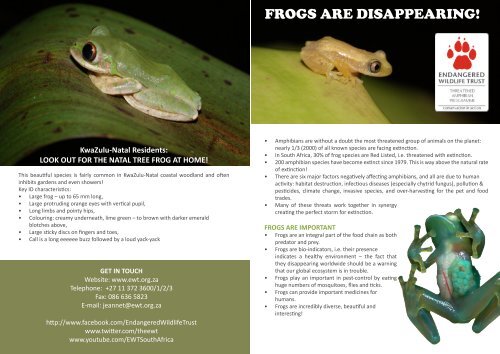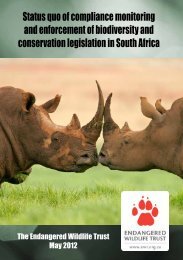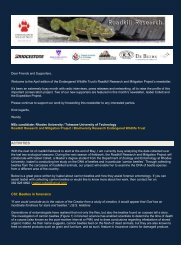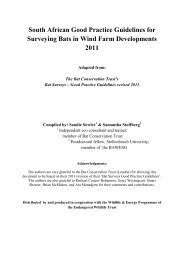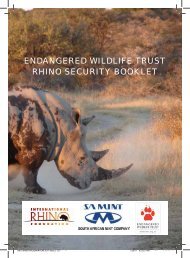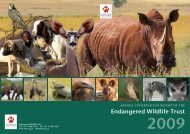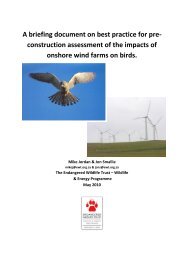FROGS ARE DISAPPEARING!
FROGS ARE DISAPPEARING!
FROGS ARE DISAPPEARING!
Create successful ePaper yourself
Turn your PDF publications into a flip-book with our unique Google optimized e-Paper software.
<strong>FROGS</strong> <strong>ARE</strong> <strong>DISAPPEARING</strong>!KwaZulu-Natal Residents:LOOK OUT FOR THE NATAL TREE FROG AT HOME!This beautiful species is fairly common in KwaZulu-Natal coastal woodland and ofteninhibits gardens and even showers!Key ID characteristics:• Large frog – up to 65 mm long,• Large protruding orange eyes with vertical pupil,• Long limbs and pointy hips,• Colouring: creamy underneath, lime green – to brown with darker emeraldblotches above,• Large sticky discs on fingers and toes,• Call is a long eeeeee buzz followed by a loud yack-yackGET IN TOUCHWebsite: www.ewt.org.zaTelephone: +27 11 372 3600/1/2/3Fax: 086 636 5823E-mail: jeannet@ewt.org.zahttp://www.facebook.com/EndangeredWildlifeTrustwww.twitter.com/theewtwww.youtube.com/EWTSouthAfrica• Amphibians are without a doubt the most threatened group of animals on the planet:nearly 1/3 (2000) of all known species are facing extinction.• In South Africa, 30% of frog species are Red Listed, i.e. threatened with extinction.• 200 amphibian species have become extinct since 1979. This is way above the natural rateof extinction!• There are six major factors negatively affecting amphibians, and all are due to humanactivity: habitat destruction, infectious diseases (especially chytrid fungus), pollution &pesticides, climate change, invasive species, and over-harvesting for the pet and foodtrades.• Many of these threats work together in synergycreating the perfect storm for extinction.<strong>FROGS</strong> <strong>ARE</strong> IMPORTANT• Frogs are an integral part of the food chain as bothpredator and prey.• Frogs are bio-indicators, i.e. their presenceindicates a healthy environment – the fact thatthey disappearing worldwide should be a warningthat our global ecosystem is in trouble.• Frogs play an important in pest-control by eatinghuge numbers of mosquitoes, flies and ticks.• Frogs can provide important medicines forhumans.• Frogs are incredibly diverse, beautiful andinteresting!
FUN FROG FACTS• There are 7,116 known amphibian species, of which 6,277are anurans (frogs and toads), 647 are caudates (newts andsalamanders), and 192 are gymnophiones (caecilians).• The word amphibian is derived from Greek and means ‘twolives’, referring to the fact that most amphibians spend theirlarval stage as aquatic, herbivorous tadpole, and their adultstage as terrestrial carnivore. However, some amphibiansspend virtually their entire lives in the water (i.e. AfricanPaedophryne dekotclawed frogs Xenopus laevis, and mudpuppies Necturus).Others, like the Puerto Rican coqui Eleutherodactylus coquiGoliath Frogor Dunn’s salamander Plethodon dunni from Oregon, spendtheir entire lives on land: they lay their eggs in moist leaflitter,bypass the tadpole stage and may never enter a waterbody.• Not all frogs have tadpoles. There are many terrestrialfrog species that emerge as froglets directly from the egg,bypassing the tadpole stage altogether.• Amphibians are the oldest land vertebrates. Ichthyostegawas an amphibian species that lived in Greenland 362 millionyears ago.• The smallest frogs are the Paedophryne dekot andPaedophryne verrucosa from Papua New Guinea, sizing in atonly only 9 mm in length.• The world’s largest frog is the Goliath Frog Conraua goliath, which lives in western Africa.They can grow to be over 30 cm (1 ft) long, and weigh over 3 kg.• Most adult frogs have lungs like yours. However, amphibians have permeable skin thatallows them to absorb both water and oxygen directly from the environment, right throughtheir skin.• A batrachologist is a person who studies amphibians. Formerly, the term herpetologistwas used, but this name encompassed those who studied amphibians and/or reptiles.• Some species only live a few years, but many live 6 or 7 years. The African Clawed FrogXenopus laevis and the Green Tree Frog Litoria caerulea can live about 30 years in captivity.• Skin secretions from at least three species of Australian frogs (the Green Treefrog Litoriacaerulea, the Southern Orange-eyed Treefrog Litoria chloris, and the Green-Eyed TreefrogLitoria genimaculata) can completely inhibit HIV, the virus that causes AIDS.HOW TO HELP• Don’t use harmful chemicals and pesticides at home and in the garden.• Build a frog pond at home or at your school!• Conserve resources – especially water!• Reduce, Re-use, Recycle!• Give toads a brake! Slow down on wet nights to avoid squashing frogs on roads.• Do NOT eat frogs’ legs.• Eat less meat: It has been estimated that producing a pound of beef requires 100times more water than does producing an equal amount of wheat. Further, a cattleranching is dependent on open spaces, and this generally means large-scaledeforestation, such as the slash-and-burn agriculture.• Use rechargeable batteries.• Don’t drink bottled water. According to the Pacific Institute, the production of 30billion plastic bottles requires the equivalent of 17 million barrels of oil (enoughto fuel more than one million vehicles for a year!), produces more than 2.5million tons of carbon dioxide, and uses three times the amount of water thanends up in the bottle.• Learn more about frogs.• Take part in Save Our Frogs Day, February 2014. For more info contact:jeannet@ewt.org.za• Donate to the EWT-Threatened Amphibian Programme:http://www.ewt.org.za/programmes/ACP/acp.htmlAfrican Clawed FrogSharp-nosed Reed Frog


